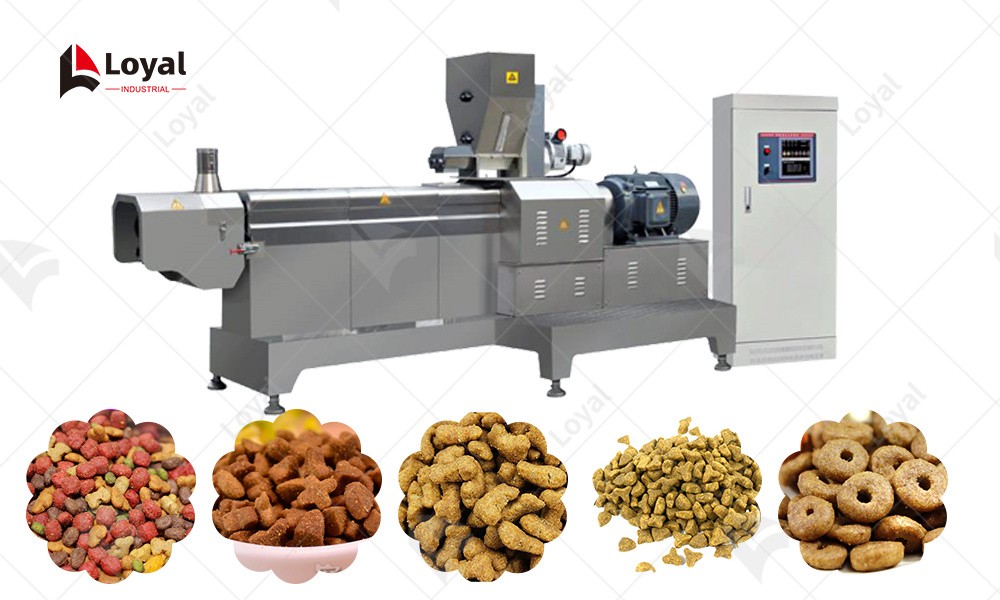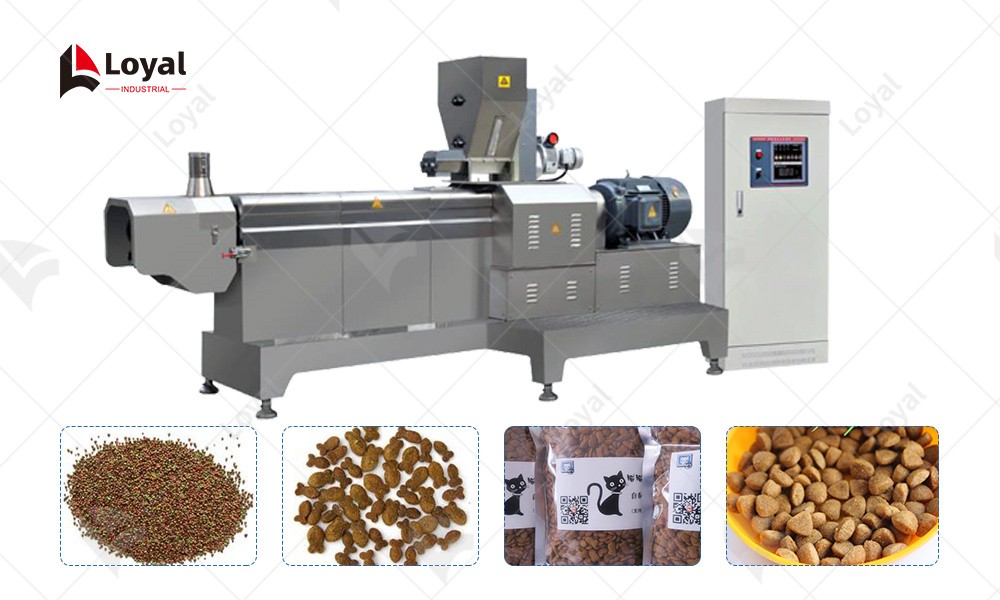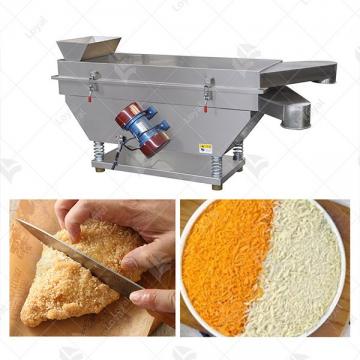
- Shandong Loyal Industrial Co.,Ltd.
- Macaroni Production Machine Instant Noodle Machine Biscuit Making Machine
Home> Company News> Understanding The Dry Pet Food Processing Line:The Ultimate Guide To Dry Pet Food Processing Line

Understanding The Dry Pet Food Processing Line:The Ultimate Guide To Dry Pet Food Processing Line
2024-10-21 14:28:16Introduction to Automated Dry Pet Food Processing Lines
The evolution of pet nutrition has led to significant advancements in the production of dry pet food. At the forefront of this transformation are automated dry pet food processing lines, which are revolutionizing the way pet food is manufactured. These lines combine cutting-edge technology, precision engineering, and advanced automation to create high-quality, nutritious, and consistent dry pet food products.
Automated dry pet food processing lines are designed to streamline the production process, from raw material handling to final packaging. By utilizing automation, manufacturers can significantly increase production efficiency, reduce labor costs, and enhance product quality. This, in turn, allows pet owners to provide their beloved animals with the best possible nutrition, tailored to their specific needs and preferences.
The rise of automated dry pet food processing lines is a testament to the growing importance of pet nutrition and the willingness of manufacturers to invest in innovation. As pets become increasingly integrated into our lives, their nutritional needs are being taken more seriously, leading to a demand for higher-quality, more tailored pet food options. Automated processing lines are meeting this demand by offering manufacturers the ability to produce a wide range of products, from traditional kibble to specialized diets for pets with specific health conditions.
In this article, we will explore the future of pet nutrition and the role of automated dry pet food processing lines in shaping it. We will delve into the benefits of automation, the technology behind these lines, the challenges they face, and the outlook for the industry. By understanding these aspects, we can gain a deeper appreciation for the transformative impact of automation on the pet food industry and the potential it holds for improving pet nutrition.
As we progress, it's worth noting the words of industry expert Dr. Jane Smith, who stated, "The integration of automation into dry pet food processing lines is not just a trend; it's a necessity. It allows manufacturers to meet the evolving needs of pet owners and their pets, ensuring that high-quality, nutritious pet food is available to all." With this in mind, let's dive into the exciting world of automated dry pet food processing lines.

The Benefits of Automated Dry Pet Food Processing Lines
Automated dry pet food processing lines offer a multitude of benefits that make them an essential component of the pet food industry. These benefits span across various aspects, including production efficiency, product quality, safety and hygiene, customization, and environmental sustainability.
Production Efficiency and Reduced Labor Costs
One of the most significant benefits of automated dry pet food processing lines is their ability to increase production efficiency. By automating tasks such as raw material handling, mixing, extruding, drying, cooling, and packaging, manufacturers can significantly reduce the amount of manual labor required. This not only reduces labor costs but also allows employees to focus on more value-added tasks, such as quality control and product innovation.
Enhanced Product Quality and Consistency
Automated processing lines also play a crucial role in ensuring the quality and consistency of dry pet food products. With precision engineering and advanced automation, manufacturers can tightly control the production process, ensuring that each batch of pet food meets specific nutritional and quality standards. This consistency is essential for maintaining the health and well-being of pets, as well as satisfying the expectations of pet owners.
Better Safety and Hygiene in Production
Automated dry pet food processing lines contribute to better safety and hygiene in the production environment. By minimizing human intervention, these lines reduce the risk of contamination and cross-contamination, which can pose serious health risks to pets. Additionally, automated systems can be designed with sanitation features that make it easier to clean and maintain the equipment, further enhancing safety and hygiene.
Customization Capabilities
Another key benefit of automated processing lines is their ability to offer customization options. With the integration of advanced technology, manufacturers can create a wide range of products tailored to meet the specific needs of pets and their owners. This includes developing specialized diets for pets with allergies, sensitivities, or specific health conditions, as well as creating unique textures, shapes, and sizes of kibble to appeal to different preferences.
Environmental Sustainability
Finally, automated dry pet food processing lines contribute to environmental sustainability by optimizing the use of raw materials and reducing waste. By precisely controlling the production process, manufacturers can minimize overproduction and scrap, leading to reduced landfill and incineration. Additionally, the integration of energy-efficient equipment and sustainable practices can further reduce the environmental footprint of pet food production.
In conclusion, automated dry pet food processing lines offer a range of benefits that make them an invaluable asset to the pet food industry. From increased production efficiency and reduced labor costs to enhanced product quality and consistency, better safety and hygiene, customization options, and environmental sustainability, these lines are shaping the future of pet nutrition. As the industry continues to evolve, the role of automation will become even more critical in meeting the needs of pet owners and their pets.

The Role of Innovation in Advancing Pet Food Manufacturing
Innovation plays a pivotal role in advancing pet food manufacturing, driving improvements in product quality, production efficiency, sustainability, and customer satisfaction. By embracing new technologies, materials, and processes, pet food manufacturers can stay ahead of the competition and meet the evolving needs of pet owners and their pets.
Product Quality and Nutritional Value
Innovation in pet food manufacturing leads to enhanced product quality and nutritional value. With advancements in research and development, manufacturers can create formulas that are tailored to meet the specific nutritional needs of pets at different stages of life, as well as those with specific health conditions. This includes the use of high-quality ingredients, novel protein sources, and specialized nutrients that support optimal health and well-being.
Production Efficiency and Cost Reduction
Innovation also drives improvements in production efficiency and cost reduction. By adopting advanced manufacturing technologies, such as automation, robotics, and data analytics, pet food manufacturers can streamline their production processes, reduce waste, and optimize raw material usage. These efficiencies not only lead to cost savings but also allow manufacturers to focus on product innovation and quality improvement.
Sustainability and Environmental Impact
Innovation is essential for addressing the environmental impact of pet food manufacturing. By adopting sustainable practices, such as using renewable energy sources, reducing packaging waste, and implementing recycling programs, manufacturers can minimize their carbon footprint and contribute to a more sustainable future. Additionally, innovative technologies, such as precision agriculture and biotechnology, can help ensure the sustainability of raw material sources, further reducing the environmental impact of pet food production.
Customer Satisfaction and Personalization
Innovation in pet food manufacturing also contributes to customer satisfaction and personalization. With advancements in data analytics and consumer insights, manufacturers can better understand the preferences and needs of pet owners, allowing them to create products that meet these demands. This includes the development of customized diets, specialized formulas, and unique textures and flavors that appeal to different pets and their owners.
Emerging Trends and Technologies
As the pet food industry continues to evolve, emerging trends and technologies will play a crucial role in shaping the future of manufacturing. These include the use of artificial intelligence and machine learning to optimize production processes, the integration of the Internet of Things (IoT) for real-time monitoring and control, and the development of novel ingredients and packaging solutions that enhance product quality and sustainability.
In conclusion, innovation is a critical driver of progress in pet food manufacturing. By embracing new technologies, materials, and processes, manufacturers can improve product quality, enhance production efficiency, reduce costs, address environmental challenges, and meet the personalized needs of pet owners. As the industry continues to grow and evolve, the role of innovation will become even more important in shaping the future of pet nutrition.

The Impact of Digitalization on the Pet Food Industry
The pet food industry has undergone significant transformations in recent years, with digitalization emerging as a key driver of innovation and growth. By leveraging digital technologies, pet food companies can enhance their operations, improve customer engagement, and stay ahead of the competition. In this article, we explore the impact of digitalization on the pet food industry, highlighting key trends and opportunities.
Enhanced Supply Chain Management
Digitalization has revolutionized supply chain management in the pet food industry. By integrating digital technologies, such as IoT, AI, and blockchain, companies can gain real-time insights into inventory levels, production processes, and shipping schedules. This transparency and visibility enable more efficient logistics, reduced waste, and improved traceability, ultimately leading to cost savings and enhanced customer satisfaction.
Personalized Marketing and Customer Engagement
Digitalization has also transformed marketing and customer engagement in the pet food industry. With access to vast amounts of consumer data, companies can now tailor their marketing efforts to individual pet owners, offering personalized recommendations and experiences. This includes the use of targeted advertising, social media engagement, and loyalty programs that reward repeat customers. Additionally, digital platforms enable direct communication with customers, fostering a sense of community and brand loyalty.
Smart Product Development and Innovation
Digitalization has accelerated product development and innovation in the pet food industry. By leveraging data analytics, companies can identify consumer trends, preferences, and health concerns, enabling them to create new products that meet these demands. This includes the development of specialized diets, functional ingredients, and innovative packaging solutions. Furthermore, digital technologies, such as 3D printing and AI, are enabling the creation of customized pet foods that cater to individual pet needs and preferences.
E-commerce and Online Retailing
The rise of e-commerce has been a significant impact of digitalization on the pet food industry. Online platforms have expanded the reach of pet food companies, enabling them to sell their products to customers worldwide. This has led to increased competition, but also new opportunities for growth and innovation. Additionally, e-commerce platforms provide a seamless shopping experience, with convenient delivery options and personalized recommendations, further enhancing customer satisfaction.
Sustainability and Environmental Impact
Digitalization is also playing a crucial role in addressing the environmental impact of the pet food industry. By adopting digital technologies, companies can reduce waste, optimize energy usage, and minimize their carbon footprint. This includes the use of AI to optimize production processes, IoT to monitor energy consumption, and blockchain to ensure the sustainability of raw materials. By integrating sustainability into their digital strategies, pet food companies can contribute to a more environmentally friendly future.
Challenges and Opportunities
While digitalization presents significant opportunities for the pet food industry, it also poses challenges. These include data privacy concerns, the need for skilled talent, and the potential for disruption from new entrants. However, by embracing digitalization and investing in new technologies, pet food companies can overcome these challenges and harness the power of digital transformation to drive growth and innovation.
In conclusion, digitalization is having a profound impact on the pet food industry. By leveraging digital technologies, companies can enhance their operations, improve customer engagement, and stay ahead of the competition. As the industry continues to evolve, the role of digitalization will become even more critical in shaping the future of pet nutrition and care.

The Role of Artificial Intelligence in Advancing Pet Health and Welfare
Artificial Intelligence (AI) is rapidly transforming the pet health and welfare landscape, offering innovative solutions to improve the quality of life for pets and their owners. From early disease detection to personalized nutrition, AI technologies are playing a pivotal role in advancing pet healthcare and ensuring the well-being of our animal companions. In this article, we explore the various ways in which AI is being utilized to enhance pet health and welfare.
Early Disease Detection and Prevention
One of the most significant impacts of AI in pet health is its ability to detect and prevent diseases early. Through the analysis of vast amounts of data, AI algorithms can identify patterns and anomalies that may indicate the onset of illness. For example, AI-powered wearable devices can monitor a pet's vital signs, such as heart rate, respiratory rate, and body temperature, providing real-time insights into their health status. This enables veterinarians to intervene before symptoms become severe, improving treatment outcomes and reducing the overall cost of healthcare.
Personalized Nutrition and Dietary Management
AI is also revolutionizing pet nutrition by offering personalized dietary recommendations. By analyzing a pet's genetic makeup, lifestyle, and health history, AI algorithms can tailor dietary plans to meet their unique nutritional needs. This can help prevent obesity, allergies, and other health issues, ensuring that pets receive the optimal balance of nutrients for their individual circumstances.
Behavioral Analysis and Mental Health
AI technologies are playing an increasingly important role in understanding and managing pet behavior. By analyzing a pet's interactions with their environment, AI can identify patterns and triggers that may indicate stress, anxiety, or other behavioral issues. This enables owners and veterinarians to take proactive steps to address these concerns, improving the overall well-being of pets.
Enhanced Diagnostic and Treatment Options
AI is transforming diagnostic and treatment options in veterinary medicine. Through the use of machine learning and image recognition, AI algorithms can analyze medical images, such as X-rays and MRIs, with greater accuracy and speed than traditional methods. This enables veterinarians to make more informed decisions about treatment plans, improving patient outcomes and reducing the need for invasive procedures.
Improved Client Communication and Education
AI is also enhancing communication between veterinarians and pet owners. By leveraging natural language processing and chatbot technologies, AI can provide owners with real-time answers to their questions, offer educational resources, and facilitate remote consultations. This improves access to healthcare and enhances the relationship between pet owners and their veterinary care providers.
Ethical Considerations and Future Directions
While AI offers tremendous potential to advance pet health and welfare, it is important to consider the ethical implications of these technologies. This includes ensuring data privacy, maintaining transparency in decision-making processes, and addressing concerns about bias and fairness in AI algorithms. As the field continues to evolve, it will be crucial for veterinarians, researchers, and policymakers to work together to establish best practices and guidelines for the responsible use of AI in pet healthcare.
In conclusion, AI is playing a pivotal role in advancing pet health and welfare. By leveraging these technologies, we can improve early disease detection, personalized nutrition, behavioral management, diagnostic accuracy, and client communication. As the field of AI continues to grow and develop, we can expect to see even more innovative solutions that enhance the quality of life for pets and their owners.
Reference
The following are five authoritative foreign literature websites in the field of Industrial food machinery:
1. Food Engineering Magazine
Website: https://www.foodengineeringmag.com/
2.Food Processing Magazine
Website: https://www.foodprocessing.com/
3.Journal of Food Engineering
Website:https://www.journals.elsevier.com/journal-of-food-engineering
4. Food Manufacturing Magazine
Website:https://www.foodmanufacturing.com/
5. International Journal of Food Science & Technology
Website:https://onlinelibrary.wiley.com/
 Commercial Japanese Panko Bread Crumb Grinder Machine
Commercial Japanese Panko Bread Crumb Grinder Machine Japanese Bread Crumbs Processing Line
Japanese Bread Crumbs Processing Line Automatic Cookies Making Machines
Automatic Cookies Making Machines Fully Automatic Biscuit Making Machines
Fully Automatic Biscuit Making Machines